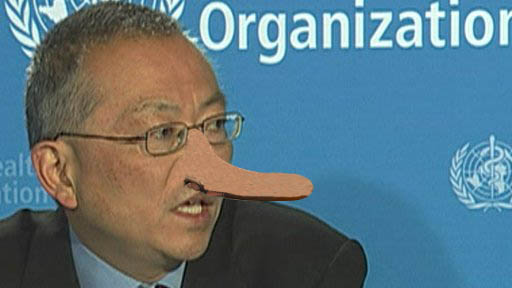Michael Fumento
Factual · Powerful · Original · Iconoclastic
Did the WHO Knowingly Hype the Swine Flu
April 19, 2010 · Michael Fumento · AOL News
The so-called "pandemic" didn't quite match up to the "best-case scenarios" of "global excess deaths in the range of 2 million to 7.4 million.
Having spread H1N1 swine flu hysteria for nearly a year, the World Health Organization’s "swine flu czar," Keiji Fukuda, last week finally "fessed up" to agency wrongdoing. But it’s like listening to Enron admitting to a tabulation error. "I think we did not convey the uncertainty" about the risks of the flu strain, he said.
Sorry, but this was no poor communications problem. Indeed, earlier this year Wolfgang Wodarg, an epidemiologist with the Parliamentary Assembly of the Council of Europe, accused the WHO of creating a "false pandemic" that’s "one of the greatest medicine scandals of the century."
At the least, by portraying as a raging razorback what proved to be more of a pathetic piglet, the WHO needlessly scared the public, wasted vast billions of dollars, destroyed the value of the term "flu pandemic" and perhaps left the organization’s reputation "tarnished" and "irreparably damaged," as one authority put it.
A year ago, Fukuda was comparing swine flu’s potential with the Spanish flu, which killed an estimated 20 million to 50 million worldwide in 1918-19, with more than half a million here. (Extrapolating to today’s population, that would be 1.5 million.) Now, with the annual U.S. epidemic ending, the Centers for Disease Control and Prevention estimates we’ve had had perhaps 12,000 total deaths—a third of the usual number. (Almost all the infections this year were swine flu.) About 140 million doses of swine flu vaccine appeared headed for the trash heap. France and Japan say their epidemics have been far milder. Last July an Associated Press headline declared, "Britain Braces for 100,000 Swine Flu Cases a Day." Actual deaths: 457.
It’s not as if the WHO knew nothing about the mildness of H1N1 early on. I wrote about it on May 1, subsequently publishing 14 articles in major publications on what I immediately dubbed hysteria. If I knew better, there’s no reason the WHO shouldn’t have known better.
Indeed, when the WHO officially labeled swine flu a pandemic in June, it was 11 weeks into the outbreak, and yet fewer people had died worldwide (144) than succumb to seasonal flu every few hours.
In contrast, the mildest true pandemic in the 20th century killed at least a million people. A recent WHO document stated that "best-case scenarios" of a new pandemic "project global excess deaths in the range of 2 million to 7.4 million," and the WHO’s own official definition required "simultaneous epidemics worldwide with enormous numbers of deaths and illness."
Slapping the "pandemic" label onto swine flu directly led to the President’s Council of Advisors on Science and Technology’s "plausible scenario" of as many as 90,000 excess flu deaths, while flu book author John Barry told Washington Post readers to expect "89,000 to 207,000" extra deaths. Yet in Australia, with the epidemic already well under way and no vaccine, people were dying at a lower rate.
So given the mild course swine flu was taking, how could the WHO justify declaring a pandemic? Easy. It rewrote the definition! The new one, viewable here and published last July, simply eliminates severity as a factor. This renders the definition meaningless, since flu always causes "simultaneous epidemics worldwide." Instead, it closely matched the new definition to swine flu by requiring that the strain contain either animal or mixed-human animal genetic material.
Now, Fukuda and other WHO officials insist the definition was never changed. In a January virtual conference, Fukuda stated, "Did WHO change its definition of a pandemic? The answer is no: WHO did not change its definition." Two weeks later, on tape at a press conference, he insisted, "Having severe deaths has never been part of the WHO definition."

Repeatedly WHO flu "czar" Keiji Fukuda has lied about the change in the WHO definition, showing the agency definitely has something to hide.
Meanwhile, here’s a news item from last May in which Fukuda himself discusses the forthcoming change, and here’s an official 2009 WHO report explaining the change in retrospect. You know, the change that never occurred.
You don’t vociferously deny doing something you obviously did with no reason. So what was it?
In part, it was CYA for the WHO. The agency was losing credibility over the refusal of avian flu H5N1 to kill as many as 150 million people worldwide, as its "avian flu czar" had predicted in 2005. Around the world, nations heeded the warnings and spent vast sums developing vaccines and making other preparations. So when swine flu conveniently trotted in, the WHO essentially crossed out "avian," inserted "swine" and WHO Director-General Margaret Chan arrogantly boasted, "The world can now reap the benefits of investments over the last five years in pandemic preparedness."
But the WHO also saw an opportunity to push a political agenda.
In a September speech, Chan said the swine flu pandemic should be exploited to fight for "changes in the functioning of the global economy," and to "distribute wealth on the basis of" values "like community, solidarity, equity and social justice." And this is supposed to be a health agency?
It would help explain why the agency hyped avian flu, why in the 1980s it exaggerated HIV infections by as much as 12-fold and why it spread hysteria over severe acute respiratory syndrome (SARS) in 2003. SARS ultimately killed a day’s worth of seasonal flu victims (and no Americans) before vanishing.
Yet with one cry of "wolf!" after another, says Europe’s Wodarg, the WHO is merely destroying "much of the credibility" we’ll need if there does appear "a killer on a large scale."
Sadly, with the swine flu debacle, that credibility may already have vanished.
